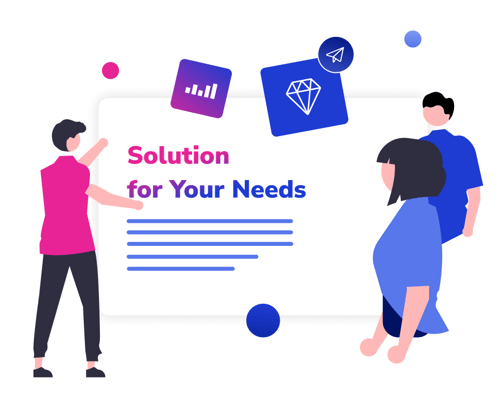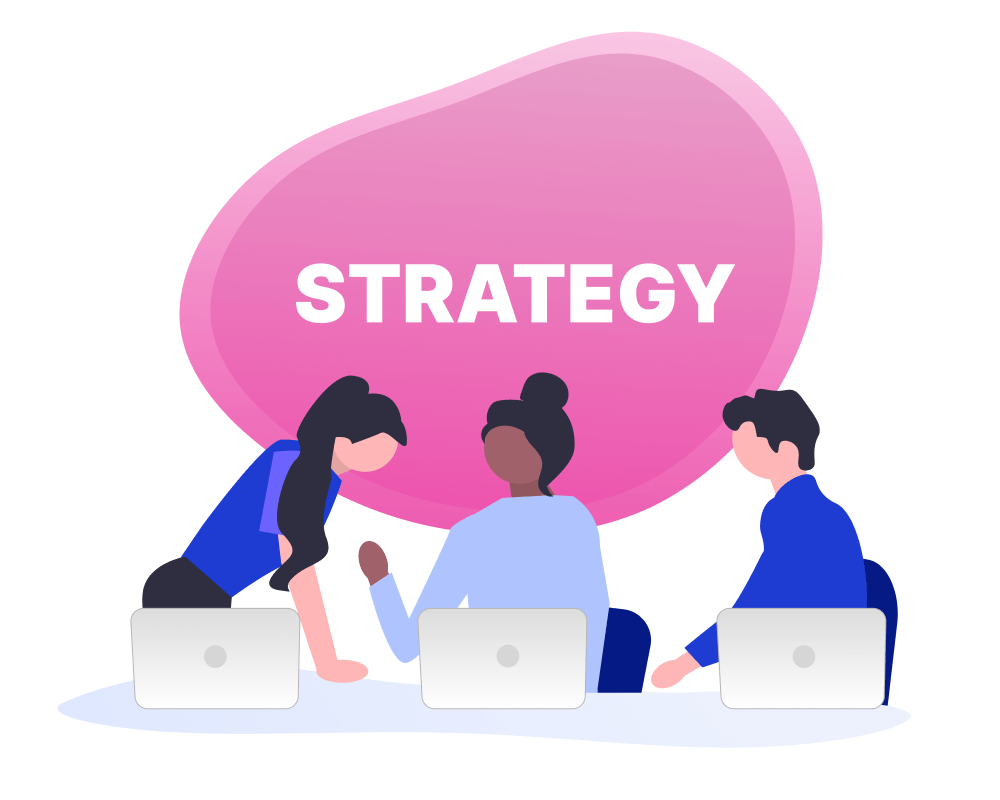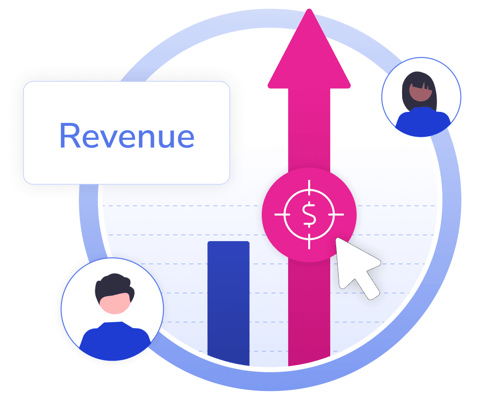Sales Enablement
Everything about Sales Enablement and how it transforms how your sales teams sell.
Picture this: your sales team brimming with potential, yet there's a noticeable gap in their achievements. Why? The answer often lies in the absence of the right tools and resources. Nowadays, sales strategies and methodologies evolve at breakneck speed, it's all too easy for your team to lose focus and fall behind.
Enter the world of sales enablement, a dynamic bridge over this gap. Think of it as your all-in-one toolkit, designed to fully empower your salespeople. With sales enablement, your team will have everything they need to shine: from one single source of truth to real-time analytics, and everything in between. This approach lifts the burden of non-essential tasks, allowing your sales team to concentrate on what they do best - selling.
Discover how it not only drives efficiency and boosts performance but also paves the way for remarkable growth in revenue for your business. It's not just a strategy; it's a game-changer for your sales force.
What Issues Does Sales Enablement Solve?
Which Companies Benefit from Sales Enablement?
The Importance of Sales and Marketing Alignment
Sales Enablement for Different Roles
How Does Sales Enablement Support Onboarding and Training?
Building a Sales Enablement Strategy
Sales Enablement Software and Tech Stack
Measuring the ROI of Sales Enablement
What is Sales Enablement?
 When you equip someone with the right tools and resources for a task, they're likely to complete it more efficiently and effectively than those without. This principle applies to your sales team, too. By providing your sellers with the necessary materials, tools, knowledge, and resources, they can convert more leads, close deals, and generate revenue for your business faster.
When you equip someone with the right tools and resources for a task, they're likely to complete it more efficiently and effectively than those without. This principle applies to your sales team, too. By providing your sellers with the necessary materials, tools, knowledge, and resources, they can convert more leads, close deals, and generate revenue for your business faster.
So, how do you ensure your sellers are well-equipped for success? This is where sales enablement comes in.
Sales enablement is the iterative process of aligning sales, marketing, and other teams to achieve business objectives successfully. It aims to equip your sales team with the relevant content, tools, knowledge, and skills needed to engage effectively with prospects and customers.
As a result of this enabling approach, you can boost revenue, win rate, and sales cycle, as well as bridge the gap between your different revenue-generating departments and teams.
Key Components of Sales Enablement Include
What Issues Does Sales Enablement Solve?
Sales enablement plays a pivotal role in streamlining and optimizing the iterative sales process and results. At its core, it addresses several prevalent challenges faced by sales teams.
Among these is the struggle many sellers face due to insufficient onboarding, training, product expertise, or the necessary skill set, which can diminish their credibility in pitches.
Also, often, teams grapple with inconsistent communication between different departments, which can send mixed signals to prospects and lead to lost opportunities.
List of Typical Pain Points that Sales Enablement Solves
Which Companies Benefit from Sales Enablement?
/world-industries.png?width=500&height=400&name=world-industries.png) Nearly all companies with a sales function can benefit from sales enablement, regardless of their size, industry, or target market.
Nearly all companies with a sales function can benefit from sales enablement, regardless of their size, industry, or target market.
Sales enablement is a good solution for any business, small, medium, and large, that has salespeople and is doing B2B, B2C, or B2B2C customer-facing sales.
It is a cornerstone of a modern organization that wants to scale performance with the help of iterative processes and digitalization.
While the advantages of sales enablement are evident for many, it's crucial to remember that every approach has nuances.
Some businesses are overly reliant on digital tools, potentially sidelining the invaluable personal connections and intuition that enrich the sales process.
For others, especially smaller entities, the task of implementing and optimizing sales enablement platforms may seem daunting.
Additionally, it's important to emphasize that while sales enablement can enhance performance, strong leadership and quality offerings remain fundamental for organizational success.
Sales Enablement for Manufacturing
Sales Enablement for Life Sciences
Sales Enablement for Financial Services
Sales Enablement for Field Sales
Sales Enablement for Wholesalers
The Importance of Sales and Marketing Alignment
Sales and Marketing are two powerful engines driving a company's growth forward. These two engines, by design, typically operate differently. They have distinct rhythms, objectives, and strategies. Both are vital, but when they operate in silos, it's akin to trying to sail a ship with two captains having different maps.
/seller-and-buyer-enablement.png?width=1000&height=600&name=seller-and-buyer-enablement.png)
The journey becomes disjointed, efforts get duplicated, and resources are misallocated. The two teams can find themselves at cross purposes, leading to missed opportunities and diluted messaging.
Without sales and marketing alignment, the organization risks sending mixed signals to prospects and clients, diminishing the brand's credibility.
Plus, when these departments aren't in sync, valuable insights that could inform strategy and drive innovation can be lost in the communication chasm. This disjoint can slow down the company's momentum and growth, reducing its competitive edge in the marketplace.
The key is synchronizing their operations for a collective purpose: Delivering unmatched value to customers.
Sales Enablement for Different Roles
 Sales enablement's influence isn't restricted to just the sales team; it pervades multiple roles in an organization.
Sales enablement's influence isn't restricted to just the sales team; it pervades multiple roles in an organization.
For sellers, it's about equipping them with the right content, tools, and knowledge to serve buyers better, tackle objections, and close deals.
Leaders and managers gain insights for effective team oversight, from performance tracking to data-driven strategies.
Marketing professionals benefit from a better alignment with sales objectives, ensuring their messaging, campaigns, and content resonate with target audiences.
Customer success and account management are empowered with collateral and insights to nurture and grow client relationships post-sale.
Meanwhile, product managers receive invaluable feedback for refining offerings.
Sales Enablement for Sellers
Showell provides quick access to relevant resources, enabling sellers to create tailored presentations and conduct engaging meetings. It helps track buyer interactions, fostering stronger client relationships and improving sales effectiveness.
Sales Enablement for Marketers
For marketers, sales enablement centralizes content management, ensuring brand consistency and up-to-date materials. It offers insights into content performance, allowing marketers to refine strategies and contribute more directly to revenue growth.
Sales Enablement for Leaders
Sales enablement gives leaders visibility into team performance through analytics. It ensures the sales team is well-equipped with resources, helps maintain brand consistency, and provides data for informed decision-making and strategy optimization.
For an in-depth coverage, read more about defining key roles and responsibilities in sales enablement.
How Does Sales Enablement Support Onboarding and Training Sellers?
/training-and-learning.png?width=500&height=400&name=training-and-learning.png) Sales enablement isn't merely a strategy to boost sales; it's also an indispensable tool for ushering in and nurturing new talent.
Sales enablement isn't merely a strategy to boost sales; it's also an indispensable tool for ushering in and nurturing new talent.
Sales enablement significantly streamlines sellers' onboarding and continuous training by centralizing relevant and up-to-date sales resources.
Having a single, accessible repository ensures that all salespeople, whether seasoned veterans or newcomers have immediate access to the latest information about products and services.
As a result of this centralization, it expedites the onboarding process for new sellers and guarantees that the entire team remains aligned and informed about new offerings.
In essence, sales enablement tools become the backbone of a knowledge-driven sales force, promoting consistency, accuracy, and efficiency across the team.
Check these comprehensive guides for more information about successful sales onboarding, and actionable steps for implementing continuous learning processes in your organization.
The Power of Effective Sales Onboarding and Training
Mastering Sales Onboarding: The Key to Success in B2B Sales
Sales Readiness: 10 Tactics for Better Sales Onboarding and Training
7 Sales Training Topics and How to Effectively Train on Them
Building a Sales Enablement Strategy
The key to a robust sales enablement strategy is to focus on delivering unmatched value to your customers: Empowering your salespeople and prioritizing collaboration and alignment with all stakeholders, including marketing, sales, production, and even buyers.

Essential steps in crafting a sales enablement strategy are:
- Ownership: Assign a dedicated person or group to drive sales enablement for streamlined and accountable implementation
- Objectives and Requirements: Define business objectives and requirements
- Buyer Journey: Map the buyer journey and review your sales process
- Budget: Allocate funds to match needed tools and training with expected results
- KPIs: Use metrics like sales cycle length and buyer experience to gauge the strategy's success and guide adjustments
- Tools: Invest in specialized sales enablement software to centralize and execute content strategies, enhancing efficiency and effectiveness.
These guides help you to navigate through sales enablement strategy creation and planning.
How to Create a Sales Enablement Plan
Step-by-Step Guide to Setting Sales Enablement Goals
Fixing Sales Performance Issues: A Guide to Sales Process Optimization
How to Set Realistic and Achievable Sales Targets: A Comprehensive Guide
How to Successfully Communicate Sales Targets to Your Team
Sales Enablement Software and Tech Stack
Technology stands as a pillar for operational efficiency and strategic growth. Among the critical technological investments that modern organizations are leaning into are the sales enablement software and the broader sales and marketing tech stack.
But what exactly does this entail, and why is it so pivotal for businesses?
/digital-sales-room-2.png?width=1000&height=800&name=digital-sales-room-2.png)
Sales enablement software is a suite of different sales and marketing tools designed to enhance the productivity, effectiveness, and alignment of both teams. These platforms centralize all sales content and resource management and serve as analytics and sales presentation tool.
Unlike basic file storage, these tools enhance and extend customer interactions by presenting, sharing, and tracking sales content. They align content with the sales journey and provide real-time analytics of sellers' and buyers' activities.
Discover what are the most essential requirements for sales enablement software.
Understanding the Sales Enablement Tech Stack
While sales enablement software forms the foundation, the tech stack often includes other sales and marketing tools.
This can encompass CRM systems for managing customer relationships, communication platforms for internal dialogues and external customer engagement, as well as other automation tools that handle routine tasks, freeing up sales reps to focus on selling.
A well-selected sales enablement software and tech stack don't just streamline the sales process; they transform it.
By leveraging the right technologies and their compatibility, businesses can empower their sales teams, foster better alignment with marketing, and drive sustainable growth in an increasingly competitive market.
The future of sales is undeniably digital, and investing in the right tools is the first step towards a more profitable tomorrow.
Sales Enablement Content
The buying journey has become more complex, and sales enablement content can dramatically help to solve complexities in the modern B2B buying journey.
It empowers sales teams to confidently communicate the value proposition of their products or services while addressing their prospects' unique needs and pain points.
By equipping sales teams with a comprehensive repository of relevant and up-to-date resources, you ensure that every interaction with potential customers is informed, engaging, and persuasive while reducing the preparation time for sellers.
/Sales-enablement-software-1.png?width=500&height=300&name=Sales-enablement-software-1.png)
Sales enablement content can be anything from presentations, brochures, case studies, technical data, and sales templates, all geared towards one thing: to help your sales team deliver unmatched value for your customers and close deals.
Content also serves other purposes.
It educates the sales team about the product or service they're selling, offers insights into the target market and its challenges, and provides the tools needed to demonstrate value to prospects.
In essence, content ensures that sellers are not just pitchmen but knowledgeable advisors to their customers.
Two Main Types of Sales Enablement Content:
- Customer-Facing Sales Content: This includes materials that directly engage the prospect, such as product brochures, case studies, testimonials, demo videos, and sales presentations. These resources enable the salesperson to paint a vivid picture of the benefits a product or service can deliver.
- Internal Learning and Training Content: Crucial for the ongoing development of the sales team, this category encompasses resources like sales playbooks, pricing guides, objection-handling scripts, product specifications, and competitive analyses. This content ensures that sellers are always prepared, no matter the situation.
Effective use and management of sales enablement content can have a huge impact on the way your sellers sell. Learn more sales enablement content, content management, and sales content analytics.
All You Need to Know About Sales Content Management
7 Types of Sales Content Needed to Close More Deals
How to Easily Create Influential Customer References
Using 3D and AR in Sales: 3 Examples
Measuring the ROI of Sales Enablement
/Performance2.png?width=500&height=400&name=Performance2.png) Sales Enablement, when executed correctly, has the potential to greatly enhance the efficiency and effectiveness of your sales process.
Sales Enablement, when executed correctly, has the potential to greatly enhance the efficiency and effectiveness of your sales process.
However, like any investment, businesses must ensure they're achieving a positive return on investment (ROI) from their sales enablement efforts.
Measuring the ROI of sales enablement is crucial for justifying its ongoing costs and refining the process over time.
With Sales Enablement, sales and marketing spend less time on back-office tasks, have more time to sell, and can increase overall sales productivity.
This results in more time for high-quality, impactful conversations with customers, leading to higher sales performance.
In the end, the ROI of Sales Enablement can be seen in faster sales cycles, more closed deals, and an increase in deal sizes.
How to Measure Sales Enablement
Sales Enablement KPIs to Track to Maximize Sales Performance
Best Sales Enablement Practices Summarized
 Sales enablement is pivotal in equipping sales teams to perform at their best.
Sales enablement is pivotal in equipping sales teams to perform at their best.
From aligning sales and marketing efforts to providing continuous training and resources, it's about optimizing each aspect of the sales process.
Implementing best practices in sales enablement not only enhances the effectiveness of your sales team but also ensures consistency in delivering value to customers.
Here are ten foundational best practices to guide your sales enablement journey forward.
1. Appoint Dedicated Leadership and Responsibilities
Appoint a specific person or team responsible for overseeing the sales enablement function. This ensures continuity, focused strategy, and optimal utilization of resources. Ensure someone is responsible for keeping tools up-to-date, content relevant, and best practices in use. Grant that person or team the time and budget necessary to accomplish their mission.
2. Create a Sales Enablement Strategy and Roadmap
Before diving into sales enablement, craft a strategy that clearly outlines your objectives which challenges it can solve, opportunities it can present, expected outcomes, and a roadmap for achieving these goals.
3. Invest in Sales Enablement Technologies
Incorporate a suitable sales enablement software and tech stack that aligns with your needs. This software should facilitate content management, analytics, and effective customer interactions.
4. Align Sales & Marketing
Foster a symbiotic relationship between sales and marketing. Ensure that both teams work closely together. Marketing should be aware of salespeople's challenges in the field, and sales should have input into the materials marketing produces. Collaboration ensures that content is relevant, consistent, and effectively addresses the pain points of prospects.
5. Centralize All Sales Content Into One Place, Available Anytime and Anywhere
Consolidate all sales-related content in a singular, accessible platform. This makes content retrieval easier, ensuring sales reps have the necessary resources when they need them. This eliminates the time salespeople spend searching for content and ensures they always have the most up-to-date information at their fingertips.
6. Provide Relevant, Diverse, and On-Brand Sales Enablement Content
Equip sales teams with a diverse range of content, catering to different buyer personas and stages in the sales journey. Ensure that this content stays true to brand identity, effectively communicates value and, address any question that may arise during the sales journey.
7. Leverage Data and Analytics to Optimize Your Sales Process
Monitor and evaluate which content pieces and strategies yield the best results, and adjust accordingly. This continuous refinement ensures that sales enablement efforts stay relevant and effective.
8. Provide Continuous Training and Onboarding
Sales enablement is not a one-off process. Regularly update and train your sales team on new products, market trends, and sales techniques to ensure they're always at the top of their game.
9. Measure ROI of Sales Enablement
Regularly evaluate the return on investment of your sales enablement initiatives and efforts. This not only justifies the associated costs but provides insights for further refinement.
10. Foster Stakeholder Collaboration
Sales enablement is a cross-departmental effort. Ensure alignment with not just marketing but also product management, customer success, and other relevant departments. By embracing these best practices, businesses can elevate their sales process, ensuring that sales teams are not only well-equipped but also operate at peak efficiency.
Sales Enablement Use Cases
Here are real-world examples of how different industries and sales organizations can use Sales Enablement to boost their sales and marketing performance.
How Sandvik is Making it Easy for Their Global Dealers to Sell
How Showell Modernizes Valtra's Global Sales and Brings the Wow Effect
A Must-Have Solution for Kubota’s Dealer Success
Further Sales Communication Resources to Enable Sales
Effective communication is the bedrock of successful sales and sales enablement.
To help sales teams harness the power of impactful communication, here are some invaluable resources that shed light on best practices, techniques, and innovative approaches. Each resource is tailored to empower sales professionals with the tools they need to engage prospects and close deals efficiently.
Preparation and Initial Contact:
7 Key Elements of How to Prepare for a Successful Sales Call
The Ultimate Guide: Top 25 Sales Discovery Questions
Sales Pitch and Buyer Engagement:
10 Secrets To A Winning Sales Presentation
5 Proven Storytelling Techniques in Sales to Improve Your Pitch
How to Begin Your Sales Presentation
16 Effective Sales Meeting Icebreakers and How to Use Them
Customer Needs Analysis: Converting Challenges into Solutions
Handling Objections and Resistance:
How To Interpret and Overcome Sales Resistance in Sales Conversations
Sales Proposal and Closing the Sales:
5 Essential Elements of a Winning Sales Proposal in B2B Sales
Asking for the Sale: 7 Key Questions and Phrases for Successful Non-Pushy B2B Selling
Asking for the Sale: When and How to Do It + 10 Questions You Can Use
"Effective Sales Enablement Platform"
"Showell is very user-friendly and simple for sales teams to adopt. I like how easy it is to navigate around the platform, share content with customers and create presentations quickly."





